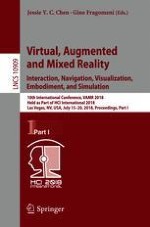2018 | OriginalPaper | Chapter
Simulation Sickness Evaluation While Using a Fully Autonomous Car in a Head Mounted Display Virtual Environment
Authors : Stanislava Rangelova, Daniel Decker, Marc Eckel, Elisabeth Andre
Published in: Virtual, Augmented and Mixed Reality: Interaction, Navigation, Visualization, Embodiment, and Simulation
Publisher: Springer International Publishing
Activate our intelligent search to find suitable subject content or patents.
Select sections of text to find matching patents with Artificial Intelligence. powered by
Select sections of text to find additional relevant content using AI-assisted search. powered by
